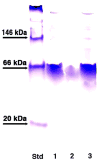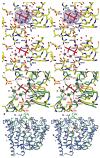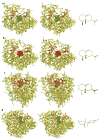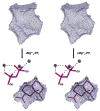X-ray crystal structure of aristolochene synthase from Aspergillus terreus and evolution of templates for the cyclization of farnesyl diphosphate
- PMID: 17261032
- PMCID: PMC2518937
- DOI: 10.1021/bi0622524
X-ray crystal structure of aristolochene synthase from Aspergillus terreus and evolution of templates for the cyclization of farnesyl diphosphate
Abstract
Aristolochene synthase from Aspergillus terreus catalyzes the cyclization of the universal sesquiterpene precursor, farnesyl diphosphate, to form the bicyclic hydrocarbon aristolochene. The 2.2 A resolution X-ray crystal structure of aristolochene synthase reveals a tetrameric quaternary structure in which each subunit adopts the alpha-helical class I terpene synthase fold with the active site in the "open", solvent-exposed conformation. Intriguingly, the 2.15 A resolution crystal structure of the complex with Mg2+3-pyrophosphate reveals ligand binding only to tetramer subunit D, which is stabilized in the "closed" conformation required for catalysis. Tetramer assembly may hinder conformational changes required for the transition from the inactive open conformation to the active closed conformation, thereby accounting for the attenuation of catalytic activity with an increase in enzyme concentration. In both conformations, but especially in the closed conformation, the active site contour is highly complementary in shape to that of aristolochene, and a catalytic function is proposed for the pyrophosphate anion based on its orientation with regard to the presumed binding mode of aristolochene. A similar active site contour is conserved in aristolochene synthase from Penicillium roqueforti despite the substantial divergent evolution of these two enzymes, while strikingly different active site contours are found in the sesquiterpene cyclases 5-epi-aristolochene synthase and trichodiene synthase. Thus, the terpenoid cyclase active site plays a critical role as a template in binding the flexible polyisoprenoid substrate in the proper conformation for catalysis. Across the greater family of terpenoid cyclases, this template is highly evolvable within a conserved alpha-helical fold for the synthesis of terpene natural products of diverse structure and stereochemistry.
Figures








Similar articles
-
Mechanistic insights from the binding of substrate and carbocation intermediate analogues to aristolochene synthase.Biochemistry. 2013 Aug 13;52(32):5441-53. doi: 10.1021/bi400691v. Epub 2013 Aug 1. Biochemistry. 2013. PMID: 23905850 Free PMC article.
-
X-ray crystallographic studies of substrate binding to aristolochene synthase suggest a metal ion binding sequence for catalysis.J Biol Chem. 2008 May 30;283(22):15431-9. doi: 10.1074/jbc.M800659200. Epub 2008 Apr 2. J Biol Chem. 2008. PMID: 18385128 Free PMC article.
-
Crystal structure determination of aristolochene synthase from the blue cheese mold, Penicillium roqueforti.J Biol Chem. 2000 Aug 18;275(33):25533-9. doi: 10.1074/jbc.M000433200. J Biol Chem. 2000. PMID: 10825154
-
Assembly-Line Catalysis in Bifunctional Terpene Synthases.Acc Chem Res. 2021 Oct 19;54(20):3780-3791. doi: 10.1021/acs.accounts.1c00296. Epub 2021 Jul 13. Acc Chem Res. 2021. PMID: 34254507 Free PMC article. Review.
-
Unearthing the roots of the terpenome.Curr Opin Chem Biol. 2008 Apr;12(2):141-50. doi: 10.1016/j.cbpa.2007.12.008. Epub 2008 Feb 20. Curr Opin Chem Biol. 2008. PMID: 18249199 Free PMC article. Review.
Cited by
-
Discovery of the cryptic function of terpene cyclases as aromatic prenyltransferases.Nat Commun. 2020 Aug 7;11(1):3958. doi: 10.1038/s41467-020-17642-2. Nat Commun. 2020. PMID: 32769971 Free PMC article.
-
Electrostatic effects on (di)terpene synthase product outcome.Chem Commun (Camb). 2011 Apr 14;47(14):4074-80. doi: 10.1039/c0cc02960b. Epub 2011 Feb 8. Chem Commun (Camb). 2011. PMID: 21305070 Free PMC article.
-
Mechanism of Germacradien-4-ol Synthase-Controlled Water Capture.Biochemistry. 2016 Apr 12;55(14):2112-21. doi: 10.1021/acs.biochem.6b00115. Epub 2016 Mar 30. Biochemistry. 2016. PMID: 26998816 Free PMC article.
-
Terpenoid synthase structures: a so far incomplete view of complex catalysis.Nat Prod Rep. 2012 Oct;29(10):1153-75. doi: 10.1039/c2np20059g. Epub 2012 Aug 21. Nat Prod Rep. 2012. PMID: 22907771 Free PMC article. Review.
-
Protonation of a neutral (S)-beta-bisabolene intermediate is involved in (S)-beta-macrocarpene formation by the maize sesquiterpene synthases TPS6 and TPS11.J Biol Chem. 2008 Jul 25;283(30):20779-88. doi: 10.1074/jbc.M802682200. Epub 2008 Jun 3. J Biol Chem. 2008. PMID: 18524777 Free PMC article.
References
-
- Glasby JS. Encyclopedia of Terpenoids. Wiley; Chichester: 1982.
-
- Cane DE. Isoprenoid biosynthesis. Stereochemistry of the cyclization of allylic pyrophosphates. Acc Chem Res. 1985;18:220–226.
-
- Cane DE. Enzymatic formation of sesquiterpenes. Chem Rev. 1990;90:1089–1103.
-
- Lesburg CA, Caruthers JM, Paschall CM, Christianson DW. Managing and manipulating carbocations in biology: Terpenoid cyclase structure and mechanism. Curr Opin Struct Biol. 1998;8:695–703. - PubMed
Publication types
MeSH terms
Substances
Associated data
- Actions
- Actions
Grants and funding
LinkOut - more resources
Full Text Sources

